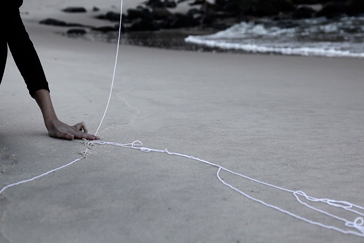
Born in Rio de Janeiro (BR) in 1982. Lives and works in Rio de Janeiro (BR).

2012
Color video.
Durée : 11'42''.
Year of Purchase: 2012
Maria Laet’s work begins with a gesture; it unfolds as a relation of encounter and dialog with the natural elements and surfaces of the world. It’s a bodily gesture in the act of displacement or breathing; a gesture of the hand in a seemingly banal act of sewing or punctuating; a gesture-sign which becomes a performance, even as it defies one of the expectations: that there be an audience. It’s a gesture performed in silence and carried out in a secret intimacy between the artist and the object—for example balloons, as in Untitled (Dialogue Balloons and Body) , 2007—or between an element and a surface—for example, between milk and the cracked asphalt pavement in Milk on Pavement (2008)… The gesture is slight, precise, as well as minimal and repetitive, akin to a ritual in its patient effort of perception, capture, and disclosure of the invisible or of the possibilities hidden in “little things.” It’s a delicate, receptive gesture that the artist—who studied, among other places, in Sao Paulo and at the Camberwell College of Art in London in 2007–2008—opens to a reassessment of nature and its organic components. Laet explores those components’ physical properties and utilizes the most basic and, above all, the most fluid, the most liquid, the most volatile, malleable, and whimsical materials: sand, snow, milk, ink, breath… She binds and bonds elements and surfaces (her 2012 entry in the 18th Sidney Biennale, entitled All Our Relations is revelatory in that regard), she questions their physical and temporal limits, as well as their inexorable excess. She retraces their nuances and memory, as well as the formal metamorphoses using a variety of media—drawing, engraving, photography, video. It is the trace that, in Laet’s practice, constitutes a museum-worthy artwork.
Sewing: an innocuous, domestic activity. Sewing the sand: a mad gesture that pushes the impossible and the vain to the limit. Stitching along the imperceptible tidal line marked by the reach of the foam of a wave on the shore: a gesture attempting to render the immaterial material, to make visible the boundary between two universes that never cease meeting and separating. Thus, in the video Notas sobre o limite do mar, we follow the artist’s hand stitching sand with cotton thread and needle, her effort, tense and repeated, then abandoned… This act, and the crumbling points of the seam, are erased by the ebb and flow of the wave. Maria Laet’s work contains living abstraction. Sewing sand represents an instant of the visible, of the intangible, and of imaginary desire, an instant of “dialog” and equilibrium between the industrious human world and nature, as powerful as it is shifting. However, it may also represent the failure of the human line to capture the mineral line, soundlessly marking the uselessness of our desire for control. It’s a sort of borderline failure that transports us to a time of erasure, disappearance, of the transitory, and of the fragility of the visible. The video becomes an image and an archive of this failure.
Marjorie Micucci